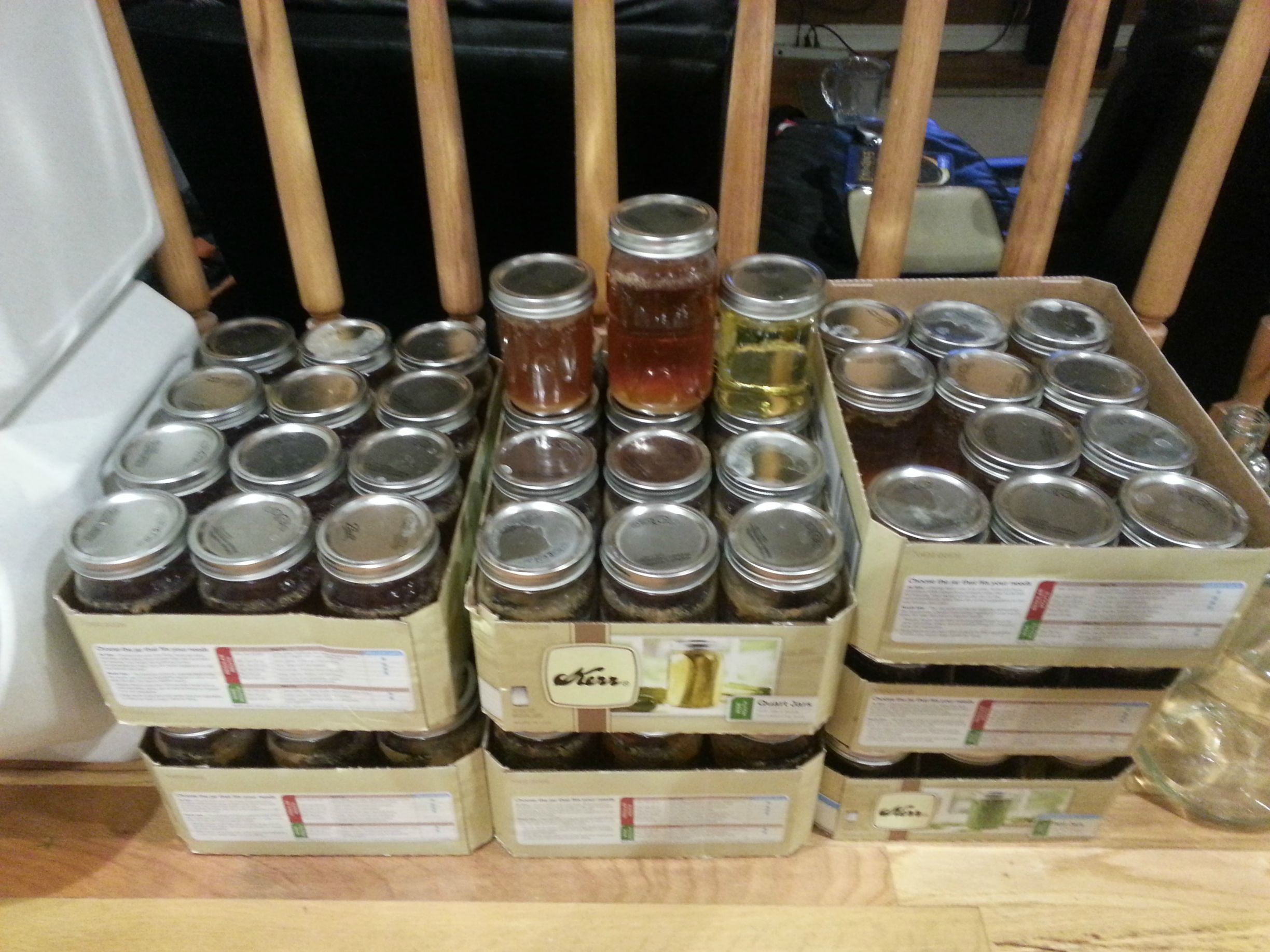This is an old thread, but certainly the most comprehensive I've found by miles compared to other canning threads, so I figured I'd add to it instead of making yet another new thread.
Using many of these tips, I bought a pressure canner and canned up ~11 gallons of starter wort from grain successfully. Total cost for materials (just grain, really) was $10.92. That's a huge savings over DME for me, and I now have starter wort on hand at the crack of the jar. Here's some tips for anybody considering doing it yourself. You could certainly use DME, but then I think you lose half of the utility and are only shifting the boiling time away from starter day onto canning day.
Use some brewing software to design the batch:
- Select the cheapest grain available, usually plain 2-row malted around 2L.
- Design for 1.040 pre-boil gravity using your own equipment profiles.
Plan volumes accordingly:
-Mason jars are volume rated to the top rim, but you can only fill them ~80% for pressure canning.
- A 12-jar case of Quarts ($10) holds 2.4 gal. A 12-jar case of Pints ($8) holds 1.2 gal.
- Conversely, a gallon of wort fits exactly into 5 Quarts, or 10 Pints, or a combination of 4 Quarts and 2 Pints.
- 4 Quarts and 2 Pints is a good ratio because it's allows for both sizes in whole cases (2 cases Quarts + 1 case Pints = 6.0 gal)
Select the right jars for your situation:
- Both regular (narrow) and wide-mouth jars work fine for canning starter wort.
- Narrow mouth jars are slightly easier to pour thin liquids with because they taper down at the jar mouth, making them great for kids or the elderly.
- Wide mouth jars are easier to store tall things in (pickles), remove thick or densely packed things (jelly).
- It's best to buy all jars with the same size to only have to keep 1 size lid on hand. Choose one, if you can work it.
-- Quarts and pints come in both wide and narrow versions.
-- Pint-and-a-half (uncommon and not very useful) and half-gallon (uncommon, but very useful for storing grains) only come in wide mouth versions.
-- Half-pints and and the three smaller jelly jar sizes only come in narrow mouth versions.
-- I would not recommend canning in half-gallons jars (potentially unsafe) or in jars smaller than pints (wasting your time).
Boiling the starter wort:
- Why bother?
- It's already going to be cooked at 250F anyway.
- Skip this step. Can straight from the tun.
Selecting a canner:
- If you buy the 23 qt model on Amazon (Presto 01781), it will work out-of-the-box using the included 15# weight and dial gauge.
-- If you ever want to use it for things other than starter wort, you'll want to buy the 3-piece (5#/10#/15#) weights (Presto 50332).
-- It's not much larger, only taller, only a few $$ more than the 16 qt, and can pressure can twice as much per run. Get this size!
-- To stack double the amount of pint my stacking, buy a second rack (Presto 85707) to prevent jar breakage.
- If you buy the 16 qt model from Walmart (Presto 01745), it comes with the 3-piece weight, but does not have a gauge.
-- It still works, but you can't watch the pressure build on the gauge and it only holds half as much wort.
- Note, with either model, you can fit fewer wide-mouth pints than narrow-mouth pints. I didn't find this to be an issue for me, personally.
Using the canner:
- Read the manual! Do a practice run with only water, no jars, and be prepared for the canner to oxidize inside (turn blackish).
- When filling jars, use only fresh lids and only tighten the ring to finger-tight -- just tight enough to hold the lid on and prevent spillage.
-- Over-tightening will prevent a good vacuum seal, the lid will still be popped outward, and you'll need to re-process that jar or use immediately.
- Always fill the canner to the lowest mark (3 quarts) if using either model listed above, then add jars.
- Follow the directions. Cook for 15 minutes at 15# (250F).
- Allow the canner to cool of its own accord! Do not try to speed it by venting steam or using cold water baths.
- Change out the water in the canner each time. It can get acidic and smell gross after more than one use.
- Use canning lifter or canning tongs to move hot jars and place in a safe place to cool. They stay hot for approximately an hour.
- Don't try to speed the jars cooling down! Don't tighten the rings for 12 hours. You may remove them if you prefer to re-use them.
- After at least 12 hours have passed, remove the ring, and wipe down the jar to remove any stray sugars if you don't want ants.
- You can store with or without rings.
Here's my successful runs so far - 4 cases of Quarts and 1.5 cases of Pints (10.70 gal of 1.039 - 14# 2-row at 82% mash eff), and an extra 1.5 cases of Priming Sugar pints. Took two days because I tried to use the smaller Walmart canner. Went way faster once the larger Amazon one arrived. 10.70 gallons of 1.039, ready for instant starters.


Good luck! Maybe if somebody finds this helpful someday, toss me a Like.





